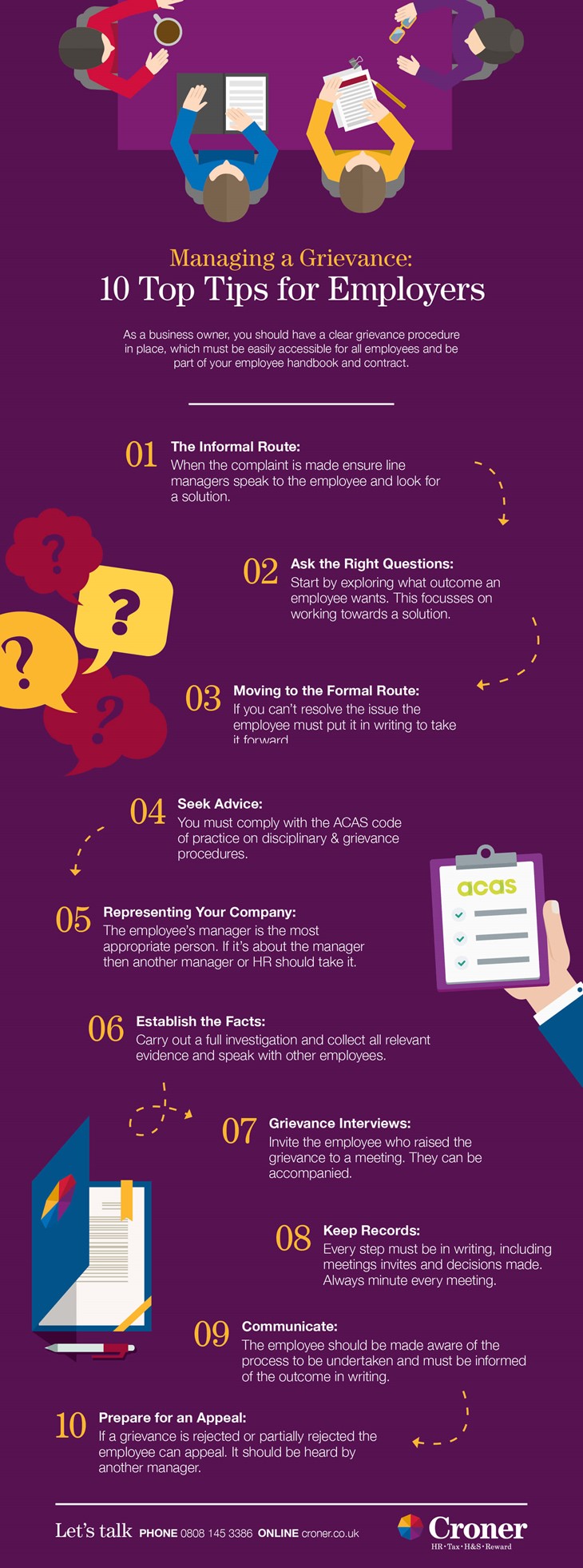Handling an employee grievance correctly can mean the difference between a successful resolution and it escalating to an employment tribunal.
You should have a clear grievance procedure in place, which must be easily accessible for all employees and be part of your employee handbook and their employment contract.
Managing a Grievance - The Stats
Add this infographic to your website by copying and pasting the following embed code:
<div style="clear:both"><a href="https://croner.co.uk/media/1877/Top-10-Grievance-Tips.pdf"><img src="https://croner.co.uk/media/1876/Top-10-Grievance-Tips.jpg" title="Managing a Grievance" alt=" Managing a Grievance" border="0"></a></div><div>Courtesy of: <a href="https://croner.co.uk/">Croner</a>.</div>
Top 10 Tips for Managing a Grievance
- The informal route: When the complaint is made ensure line managers speak to the employee and look for a solution.
- Ask the right questions: Start by exploring what outcome an employee wants. This focuses on working towards a solution.
- Moving to the formal route: If you can’t resolve the issue the employee must put it in writing to take it forward.
- Seek advice: You must comply with the ACAS code of practice on disciplinary and grievance procedures.
- Representing your company: The employee’s manager is the most appropriate person. If it’s about the manager then another manager or HR should take it.
- Establish the facts: Carry out a full investigation and collect all relevant evidence and speak with other employees.
- Grievance interviews: Invite the employee who raised the grievance to a meeting. They can be accompanied.
- Keep records: Every step must be in writing, including meetings invites and decisions made. Always minute every meeting.
- Communicate: The employee should be made aware of the process to be undertaken and must be informed of the outcome in writing.
- Prepare for an appeal: If a grievance is rejected or partially rejected the employee can appeal. It should be heard by another manager.
If your business requires support and advice with a case of harassment contact 0808 145 3490
Related resources
Categories
- Business Advice
- Contracts & Documentation
- Culture & Performance
- Disciplinary & Grievances
- Dismissals & Conduct
- Employee Conduct
- Employment Law
- End of Contract
- Equality & Discrimination
- Health & Safety
- Hiring & Managing
- Leave & Absence
- Managing Health & Safety
- Moving
- Occupational Health
- Pay & Benefits
- Recruitment
- Risk & Welfare




